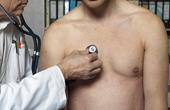Nutrition for Hypertonic Disease

The diet of hypertensive patients is little different from a diet intended for patients with atherosclerosis. It is necessary to reduce the total caloric intake, to limit salt intake, to exclude extractives, to reduce consumption of animal fats and fluid intake.
It is necessary to increase the consumption of products containing potassium and magnesium salts. The meal is carried out 4-5 times a day, in a relaxed atmosphere, at the same time.
Studies have shown that even a small reduction in caloric intake can lead to lower blood pressure. In particular, the reduction in the calorie content of the diet for patients who are overweight is shown, for which it is also possible to recommend the carrying out of kefir, apple, rice-compote and vegetable-fruit unloading days. The common feature of these fasting days is the decrease in caloric content and the decrease in the content of common salt, protein and fat in food.
An extremely important point is the limited consumption of table salt due to the peculiarity of the sodium that enters it, to have a pronounced vasoconstrictive effect. This, in turn, can cause an increase in blood pressure. Studies show that even in the most neglected cases, a significant reduction in blood pressure can lead to a decrease in salt intake to normal levels( 4-6 g / day), instead of the usual 15-20 or more grams.
To sharply limit the consumption of table salt allows the use of a rice-compote diet, which includes products such as 300 grams of rice, 2 kg of fresh fruit, 100 g of sugar or jam, and the dishes are prepared without dosing food. Such a diet is characterized by 20-25 protein, 4-6 g fat, 450 grams of carbohydrates and only 0.15 g of table salt, its calorific value is 2000 calories.
Such a diet because of its non-physiological, monotonous and low protein content should only be used for a short time.
A favorable effect on the course of atherosclerosis, which usually accompanies hypertension, has a restriction in the diet of foods rich in cholesterol, animal fat.
Abundant drink causes an increase in the volume of circulating blood, which, in turn, leads to an increase in blood pressure. As a result, there is an increase in the load on the cardiovascular system and the kidneys. This circumstance necessitates a reasonable limitation of fluid intake.
It is necessary to limit various sharp snacks, salty, strong meat broths, tea, coffee and alcoholic beverages because of their exciting effect on the nervous system.
It is advisable to introduce into the diet of products rich in potassium, the content of vortgos should prevail over the content of sodium 7-14 times. Sources of potassium salts are potatoes, carrots, cabbage, apricots, dried apricots, raisins, prunes, figs, dates, bananas, nuts, oatmeal, millet and buckwheat porridge. Excess intake of potassium salts causes the removal of excess sodium salts from the body, which ultimately leads to a decrease in blood pressure.
Reduction in blood pressure can also be due to an increase in the content of foods rich in magnesium compounds products. This leads to inhibition of excitability of the vasomotor center of the brain and a decrease in the tone of the muscular wall of the arterial vessels. Sources of magnesium salts are wheat bran, wheat bread, rough cheeses, cereals( except manna), beans, peas, soy, nuts, raisins, figs and vegetables.
The content of a large number of vegetables in the diet causes a decrease in total caloric intake, while contributing to the onset of a feeling of satiety due to its volume.
Materials used:
Shilov VN, Mits'yo VP"Healthy Nutrition"
